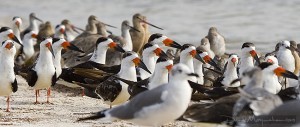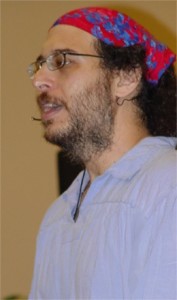A really good contradance is the closest I’ve come to flying in a flock of shorebirds. In this kind of dance, you and your partner move with another couple through a series of figures with evocative names like Mad Robin, Box the Gnat, California Twirl, Ocean Wave, and Hey for Four.
What transforms a contra from a series of rote steps to a transcendent experience is the ability of the group to synchronize. You need a room full of people working together, moving in time to music. When a great caller and a fabulous live band drive the movements into your body memory, that synchrony can happen. It feels to me like being in a company of wild birds.
Last weekend, Jeff and I drove south to the Florida Snow Ball, as we do every January, to Gulfport. There, the Casino Ballroom perches on the north shore of Boca Ciega Bay, a water body so developed that its tiny swath of sand is highly prized, both by people and shorebirds.
From where we whirled on the white maple ballroom floor, I could see assemblages of black skimmers, willets, and several varieties of gull resting on the beach. They were as connected to one another as the dancers inside.
But unlike the dancers and the Gulfport beachgoers, the birds’ options were limited. We dance or walk along the shore for pleasure, but shorebirds need the beach for sleeping, feather care, eating, and nesting. The restive and rare birds—like the black skimmers I watched outside the windows–were the first to be displaced. Willets and sanderlings will sometimes skip ahead and then double back to the same feeding spot after danger passes, but the shyest species will not. Human disturbance renders the beach almost unusable to its original inhabitants.
Each time I caught a glimpse of the birds swirling into the air, describing currents in space with their bodies, I knew that something had scared them off the sand. In this urban setting, the birds weren’t moving for the pleasure of flocking in flight: inevitably it was because humans and their dogs walked oblivious into the shorebirds’ assemblies. But I even watched people run and even stamp at the rare congregations of birds, just to see them fly, or to take pictures, reducing the living beings to mere spectacle.
At Snow Ball, Jeff and I learned a new dance figure: Yearn Left. We stood in a line of couples, holding hands, facing a long row of other pairs. The caller—my favorite, Seth Tepfer—directed us feel pulled…drawn…to the couple standing on the left diagonal.
“Let the emotion of yearning draw you forward to that next couple you will be dancing with,” Tepfer explained. The Yearn is a very simple movement, but full of feeling. As we incorporated the figure into a sequence with others we already knew, Seth gradually withdrew his words. Through the microphone came just a whispered hint to remind us of our next move.
“Sssss…..”, he whispered, when it was time to Circle Right. “Hhhhhh-aaay…for Hey for Four, and then “Y-y-y-ya…” and we knew it was time to Yearn. Like the shorebirds, a group mind gradually infused the dance and the dancers with elastic, joyful connection.
I believe the yearning so many of us feel has to do with all the ways we’ve been cut off from the natural world. A first step to healing our loneliness is to pay attention to and honor, the needs of all of Earth’s life forms. There they are: right outside the window!

These birds were photographed by David Moynahan, but not at Gulfport. Look at the beautiful black skimmers!
Share On:





Lovely!